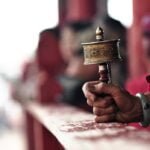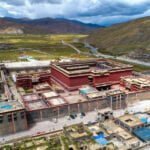Trisong Deutsen was an advocate of Buddhism but faced opposition from his conservative and xenophobic ministers who preferred the Bon religion. In 761, he dispatched his minister Selnang (gSal-snag) to Nepal to invite the Buddhist master Shantarakshita, who was the abbot of Nalanda Monastery, the most esteemed Buddhist centre of learning in northern India.
The arrival and teachings of the Indian master in Tibet allegedly angered the local Bon spirits, resulting in numerous storms and floods. According to other accounts, a smallpox outbreak also occurred. Due to pressure from his xenophobic pro-Bon ministers, Shantarakshita was held responsible for the calamities and was expelled from Tibet. However, before departing for India, Shantarakshita recommended that the Emperor invite the powerful Buddhist master Padmasambhava of Oddiyana, which is located in the present-day Swat Valley of northwestern Pakistan, to suppress the Bon spirits.
Tri Songdetsen subsequently followed Shantarakshita’s advice and invited Padmasambhava to Tibet. He also invited Shantarakshita to return. Selnag led the Tibetan delegation to accompany the Indian master once again.

Samye Monastery Construction – Trisong Detsen
The first monastery in Tibet was constructed by Emperor Trisong Detsen. As per most accounts, the construction began in 766 and was finished by 775. The monastery, known as Samye was designed based on Odantapuri, a new Indian monastery that was built a few years prior under the patronage of Emperor Gopala (r. 750 – 770), who founded the Pala Dynasty in India.
Padmasambhava left Tibet before the completion of Samye, but before he left, he concealed various texts related to the advanced meditation system called “Dzogchen” inside the monastery’s walls. Padmasambhava believed that the Tibetans were not yet developed and mature enough to understand these texts, so he kept them as “treasure texts” (gter-ma) to be discovered later when the Tibetans were ready to comprehend and practice them correctly.
Initially, Samye was occupied by the first seven Tibetan monks who founded a school for Sanskrit and translation. Shantarakshita and his Indian disciples who accompanied him to Tibet ordained these monks. The scholars at Samye not only translate Buddhist texts from Sanskrit but also from Chinese into Tibetan. Some scholars also translated Bon’s texts into Tibetan from the Zhang-Zhuang language.
Shantarakshita passed away at Samye in 783, and in the same year, Emperor Trisong detsen established a Religious Council to handle all religious matters. He appointed Selnag (gSal-snag), Shantarakshita’s successor to the abbotship of Samye, as the chief minister of the Council. Kamalashila led the pro-Indian group in Tibet and, to guarantee the direction in which Tibet would develop, he influenced the Emperor to give the Council the power to override decisions made by other ministers.
One of the Council’s initial actions in 784 was to exile the conservative xenophobic Bon faction within the imperial court to Gilgit (present-day northern Pakistan) and Nanzhao. Following Padmasambhava’s example, the Bon master Drenpa-Namka (Dran-pa nam-mkha’) also concealed various Bon texts covering all topics in the mud walls of Samye for protection.
The Great Samye Debate about Buddhism.
Prior to his demise, Shantarakshita prophesied a clash between two sects of Buddhism. One was the Chinese Chan School which taught immediate enlightenment through cessation of all thought and action, while the other was his own Indian school that advocated a gradual path of learning, analysis, and virtuous conduct. He instructed his disciple, Kamalashila, to represent the Indian system.
A prolonged argument between the two schools took place at Samye from 792 to 794. The Chinese school was represented by a Chinese monk named “Hoshang” (Ho-shang Ma-ha-ya-na), with Hoshang being the Chinese term for “monk”, and Kamalashila represented the Indian school. The Indian system was deemed to be the winner, and Emperor Trisong Deutsen officially declared it as Tibet’s official religion.
The political turmoil of the second half of the eighth century, marked by ongoing border conflicts with China, may have influenced the outcome of the Samye debate. Hugh Richardson notes that monks from Tibetan noble families who were either pro-China or anti-China were present at the debate, indicating a political struggle.
Tibet – Chinese War – Tang Dynasty
In 763, during Shantarakshita’s exile from Tibet, the Tibetan army even captured the Tang capital Chang’an and held it for fifteen days before withdrawing. This occurred after the Chinese had crushed the An Lushan Rebellion but before the new Tang Emperor, Daizong returned to Chang’an from Luoyang.
Despite the peace treaty of 783, which established the Sino-Tibetan boundary in Amdo and gave Tibet control of the Kokonor regions, war broke out again in 786. The conflicts were not limited to the Amdo borders and Silk Route regions, as Tibet had formed military alliances with various kingdoms, including Nanzhao. King Kolofeng of Nanzhao had rebelled against China and allied with Tibet in 750, and Tibet and Nanzhao fought the Chinese together in Sichuan in 778. However, Nanzhao later realigned with China under King Imoshun, leading to renewed warfare between China and Tibet. The Kingdom of Nanzhao existed until 902. The capture of Dunhuang in 781 by Tibetan forces led to the establishment of a cave monastery complex that became a centre for translating Buddhist texts into Tibetan, including Dzogchen and a Tibetan form of Chan Buddhism.
King Trisong Deutsen’s Expand to Northern Territory
In 790, Tibet regained control of the four outposts of Anxi, which had been taken by China under Empress Wu Zaitian in 692. Empress Wu had taken over the Tang Dynasty by declaring herself as the future Buddha, Maitreya. Tibet took over Khotan in 790, thereby acquiring power over the entire southern Tarim Basin section of the Silk Route. Although Tibet had control over Kashgar as well, they did not govern the other two Anxi outposts.
Between 785 – 805, Tibet launched repeated attacks towards the West. At that time, Tibet was in an alliance with the Qarluq Turks and Turki Shahis, who were fighting against the Abbasid Arabs. The Qarluq Turks, who lived in present-day Kyrgyzstan, later established the Qarakhanid Empire (840 – 1137) in that region. The Turki Shahis ruled the Kabul Valley and southeastern Afghanistan from the mid-fifth century until 870. During that period, their kingdom was a vassal state of Tibet.
The Tibetan army crossed the Pamir Mountains and went as far as the Oxus River, which is now called the Amu Darya River. It runs from the Pamir Mountains along the border of Tajikistan and Afghanistan and then through Uzbekistan to the Aral Sea. To halt their progress, the Abbasid Caliph Harun al-Rashid (r. 786 – 809) formed an alliance with China. The lake to the north of the Oxus River, known as “Al-Tubbat” (Al-tu-sbag) in Arabic, was named after Tibet. In Tibetan, it was referred to as “Small Lake” (mTsho-chung).
Therefore, during the time of the Samye debate, Tibet and China were engaged in a war on three fronts, not just two. This most likely played a role in China’s defeat in the debate and Tibet’s decision to reject Chinese Buddhism and adopt Indian Buddhism instead.















